Project Management in the Fuzzy Front End
In many organizations the pressure on the Product Development Process (PDP) has increased through the demand of greater product varieties and shorter lifecycles. Organizations aim for a structured way of speeding up the Product Development Process while not loosing effective scoping in the identification of market needs. Often they have succeeded in structuring the procedure using the Stage Gate Process - or a customized version of it. [1] Yet the application of the Stage Gate Process has shown that it depends largely on the tools applied. Since all innovations, incremental and radical, bring market, technological and organizational uncertainties which only vary in their intensity, it is key for the project manager to select suitable tools. [2] Especially during the initial stages of the Product Development Process - the Fuzzy Front End - the uncertainties are highest accompanied with the severeness of the decisions taken during this period. To release some pressure from the project management in the Fuzzy Front End the application of the Delphi Method, Quality Function Deployment and Risk Assessment is proposed. These can answer to each type of uncertainty and can guide the project management in combination with other tools if applied in a flexible way to success of the product development.
Contents |
The "Fuzzy Front End"
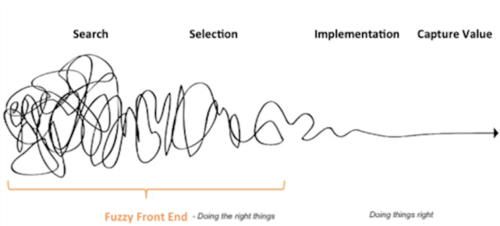
The Management of Innovation can be divided roughly into 4 stages:
- Search - Finding opportunities for innovations
- Select - Selecting the ideas to pursuit
- Implement - Development of the product and launching it on the market
- Capture - Capturing value from the innovation
On one hand most of the parameters for the later success or failure are set in the first two stages. On the other hand project managers are reluctant to make fast decisions because these stages are characterized with the highest risk and uncertainty levels of the whole process of innovation. The Search phase involves detecting signals in the environment like e.g. technological opportunities or changing requirements in the market. Here opportunities can be easily overseen. The Select phase the inputs from the Search phase are distilled and very few converted into an innovation concepts. Based on these concepts the whole organizational mechanism can now implement the innovation and capture value. [4] Hence in Innovation Management the Fuzzy Front End is considered the period between when an opportunity for a new product is first considered until the concept if the innovation enters the formal product development process.[5]
Innovation management distinguishes two types of innovations: incremental and radical. incremental innovations are characterized by minor changes in existing products which cumulatively improve their performance. [6] The Fuzzy Front End end ist characterized by a comparably low level of uncertainties since; an earlier version of the product is already on the market, the market is known to the company and risks like the technical feasibility or hence market adaption can be estimated quite well. [7]
Radical Innovations on the other hand, also breakthrough innovations or discontinuous innovation, completely change the nature of the product and bring hence a very high degree of novelty. These innovations often change the rules of their industry through opening up new opportunities but also challenging the existing players to reframe their operations. Therefore the Fuzzy Front End of these type of innovation is characterized through a high degree of market and technological uncertainties. Furthermore they often have to "fight" for the internal acceptance within the company and bring therefore organizational uncertainty. [6][8]
Project Management
Definition and Relevance for Innovation
The aim of Project Management is that projects are properly planned and controlled so that the risks are limited, seized opportunities and project goals high, on time and be accomplished within budget. It is defined as a set of management tasks, organization, techniques and materials for the development of a project. [9] Typical for product development projects is that in the very initial stages the resource commitment is still low, while there is a very high degree of uncertainties. Throughout the project the uncertaities decrease but the resource commitment increases strongly. In many cases high resource commitment can create a "lock-in" effect and leads organizations into pursuing projects which will fail in the end hoping, since they have invested heavily already, for a high return on invest. [1] To avoid costly "lock-in" effects project management is highly relevant not only for the successful execution of the goal set within the quality, costs and time aimed for, but also regarding the correct setting of the goal. In terms of the project management in the field of product development this means to choose the "right" ideas to implement and launch as innovations on the market.
Challenges of Project Management in the Fuzzy Front End
In both cases, incremental and radical innovations, project managers need to cope with market and technology uncertainties as well as potential internal resistance from the organization. However individual projects differ in the degree of severeness of these uncertainties. What is more is that innovations are not divided into incremental or radical only - all kinds of steps in between are also possible. Hence project managers in the Fuzzy Front End need to find a way to deal with a high degree of uncertainty in his/her project. In general it can be said: the higher the amount of planning is in the beginning of the project, the higher the success. But planning refers not only to the time-scheduling, the detailed definition of work-packages to be done and the assignment of resources to the project. In this case planning also refers to the extinction of uncertainties or assessing them as risks. Therefore determines the planning work of the project manager in the Fuzzy Front End the later success.
Project Management of Innovations in the Fuzzy Front End
The Stage Gate Process
Many organizations succeeded in structuring the project execution of an innovation. The most typical way to orchestrate the innovation process is through the Stage Gate Process - or an individualized version of it. It resembles a structured process with milestones - the "Gates" - which force the team to make stop/go decisions at each of them. Along with the "go" decisions comes an increased resource commitment. The further the project develops, and the higher the resource commitment gets, the more seniority will have the staff to make the stop/go decisions.
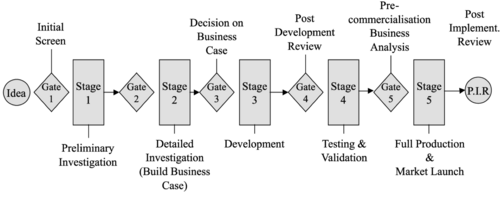
The original Stage Gate Process was developed by Cooper in 1993 and included the following five stages:
- Preliminary investigation - a fast examination and scoping of the project
- Detailed investigation - detained analysis which results in a business case, a project definition and project plan
- Development - design and development of the actual product
- Testing and Validation - trials on the marketplace and laboratory to test the market and technical feasibility to reach a product validation
- Full Production and Market Launch - commercialization, full production, marketing and sales [11]
Nowadays many companies have changed the nature of their innovation process however from a linear process to a model of feedback systems between the individual stages - creating "learning loops" and adjustments. [12] With respect to the Fuzzy Front End the first two Stages - Preliminary Investigation and Detailed investigation - are of interest since they set the scope for the following development project. In terms of project management it is key to identify the most promising ideas. Since, as described above, this period is characterized through market, technological and organizational uncertainties tools like the Delphi method, Quality Funktion Deployment and Risk Assessment can be applied. In the context of the Stage Gate Process they help the project manager to control the spending of resources and to ask frequently "should we go on?".
Reduction of market, technological and organizational uncertainties
Delphi-Method
Customer Market surveys, Internal Analysis (e.g. Brainstorming), Scenario Development based on computer simulations and external assessment like the Delphi Method are only a few examples of how organizations try to gain insight into potential markets and henceforth reducing market uncertainties. However each of the methods has its restrictions. Sometimes a consumer does not know what he wants exactly since he only speaks and desires what is known to him. Hence it is difficult to gain valuable insight from customer surveys about potential innovations which deviate from known solutions. A similar effect can be observed by the internal analysis or the computer based scenario development. Creativity and knowledge about markets and their needs are limited within the organizations and therefore employees see the problem through the internal "lens". To find unusual solutions organizations have started to search outside of the company-boundaries through e.g. the application of the Delphi method.
The Delphi method can either be used in cases of a lot uncertainty or for long time horizons and is typically applied in the "search"-phase of the Stage-Gate Process. Because it bases on the opinion of experts it is key to choose them carefully and be fully aware of their level and area of expertise. Based on the type of experts present the facilitator of the Delphi method can choose and structure the questions accordingly. The initial step of the Delphi method is a postal survey about what the experts identify as the future key issues and their future developments. The results are then analyzed and a more tailored questionnaire send out to them again. This procedure is repeated until some kind of convergence in the answer of the experts is revealed. The process typically ends if a range of experts agree upon the probability of certain events by a quoted time. If no consenuss can be reached this method can still provide important information. Special attention should be payed to the cases which differ dramatically from the common opinion since these experts could have valuable information for their stand-point. Using this method it direct contact with from the experts with each other can be avoided. This way mutual power or reputation influence on each other, reluctance to admit errors or the need to conform with a group can be avoided.
Although the Delphi-Method has shown to be very useful a project manager can not rely alone on this tool. It should be used in an individual composition together with other tools to gain a holistic insight into the market and the current technological possibilities. Furthermore since it is a tool that relies strongly on human capabilities the outcome of the Delphi-Scession depends a lot on the experts invited and the moderator being able to extract their knowledge from them. Furthermore special attention needs to be payed to the design of the questionnaires to NOT influence the outcome through a certain form of asking. In poor cases key customer needs can be missed because the experts invited do not have the necessary insights into the customer, the group collaboration suppresses opinions of members or the moderator is not able to see the value in the contributed suggestions of the members and hence the idea is dismissed. With sufficient experience of the project manager, design of the questionnaires and resources all the shortcomings of the Delphi method can be overcome however.
Quality Function Deployment
After the market has been investigated and the needs identified as well as the technology for the development generally clear it is the task of the project team, guided by the project manager, to assure that they are translated into a tangible product. First the gathered information needs to be translated into functions and integrated into the product concept. Literature finds multiple ways to realize this step however in practice organizations which apply the concept of Quality Function Deployment (QFD) reach high success rates with their products.
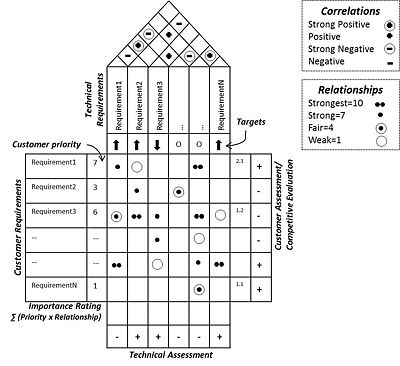
The QFD translates customer required characteristics by means of a matrix into technical specifications. Hence it is applied in the "Selection-Phase" within the Fuzzy Front End to concretize the innovation concept. The development of the relationship matrix - the House of Quality - requires a high amount of technical and market research. it is important to understand potential trade-offs which the customer might have to accept and how he/she would decide in that case.[14] In this method it has shown to be highly successful to include as many knowledge fields related to the product during the QFD-sessions as possible. Especially the collaboration between the technical staff and the marketing employees succeeds in translating the customer needs into technical specifications best. [15] The application of the QFD matrix involves the following steps:
- Identification of the customer requirements, dislikes and how he/she would react in case if trade-offs (left column)
- Ranking of the requirements according to their importance (left column)
- Translating of customer requirements into technical requirements (upper row)
- Establishment of a relation between customer requirements and technical requirements, and estimation of the strength of their relation (center of the House of Quality)
- Selection of KPIs and determination of target values (technical, financial, qualitative based on customer perceptions) based on customer requirements and competitor benchmarks (bottom and right column) [14]
Key of applying QFD after the Delphi-method is that the gained insights regarding market and technology uncertainties can be used in this step. It is obvious that a real market survey is indispensable regarding the customer insights. Since the whole process is very interdisciplinary it also stimulates communication within the project team. It has been proven highly effective of use QFD in combination with rapid prototyping. [15] Thus a "close-to-final" version of the product can be created and testes as fast as possible. Furthermore appear tangible products often more convincing and can enhance the internal support of the organization of the project.
Limitations of the QFD are that it is very time consuming, requires a lot of preparation and the collaboration between e.g. the technical and marketing staff is not always easy. With a project manager of high emotional intelligence acting as a facilitator however the QFD process can turn out highly successful.
Risk Assessment
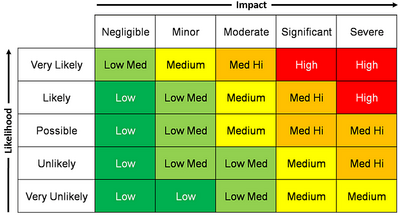
The method of Risk assessment evaluates risks based on their severity of impact and their probability of occurrence. Many studies have shown that project managers are generally poor in estimating the risks in a quantitative way - therefore the proposed risk assessment to be used in the Fuzzy Front End represents a quantitative evaluation. [17]The quantitative risk assessment also avoids the effect of fictitious precision as can be created in alternative risk assessments like e.g. FMEA or the Monte Carlo Simulation.
To identify risks and evaluate them the experts from the Delphi method can be invited since they have not only knowledge about potential future opportunities but also the risks connected to them. Additionally internal staff should join the risk assessment to estimate internal risks as well as general risks. The assessment of the risks includes the following steps:
- Identify the risks
- Evaluate the risks in terms of there severity of impact and their probability in occurrence
- Decide on strategies to handle the different risks
Typical categories to consider are the market and technology as mentioned before, time, costs, quality, health and safety as well as legal risks. [18] The first assessment could be conducted in a hidden way (e.g. every participant writes the his/her evaluation down). Then the results can be ordered in a anonymously visual way and discussed openly with the group. Then the participants can be asked to evaluate the risks again in a hidden way - now after they have discussed all the relevant perspectives. As in the Delphi-method it i hoped to reach a consensus. Since it represents a qualitative assessment it can be expected that the results will be similar in the second round.
Typical strategies to handle risks and recommendations when to apply them:
- Mitigation: Usage when the probability is high but the impact low e.g. through a management control system or the integration of sufficient buffer
- Avoidance: Application with risks of high probability and high impact e.g. through adjustments in the technology, distribution or collaboration partners
- Transfer: For risks of low probability but high impact e.g. through an insurance company
- Acceptance: If the costs to implement a mitigation/avoidance/transfer strategy is higher than its impact or the risk can not be avoided [19]
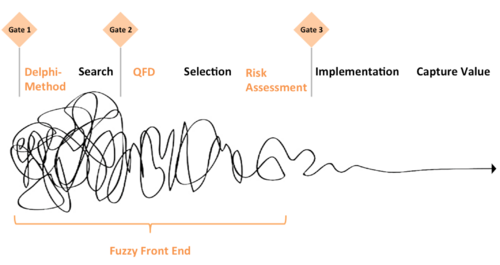
The risk assessment is the last step in the proposed project management in the Fuzzy Front End. The risk assessment creates a foundation and can represent a milestone for another go/stop decision of the project - but this time the decision should be made from a member of the organization of higher seniority. The presentation of a professional risk assessment and the actions drawn upon it could finally trigger the internal acceptance of the project. If the organization is presented with the identified risks and an action plan on how to treat them in combination with a product which is tailored to the marked needs and maybe a prototype it should be feasible to get internal approval. The final Process for Project Management in the Fuzzy Front End can be seen in Figure 5.
Limitations and Outlook of the Project Management in the Fuzzy Front End
Project Management in the Fuzzy Front End is characterized with a lot of uncertainties. As mentioned above the market and technology represent the key risks, but also the internal acceptance within the organization can suppress great innovations. Literature shows multiple tools to cope with different situations but all "one-fits-all"-approaches to the project management in the Fuzzy Front End result in practice in a "one-fits-none" solution. Fuzzy Front Ends are as diverse as the projects they concern. Even though parallels could be found in the technological and market aspect e.g. in the development of cell-phones for Apple or Samsung, the project manager has to deal with the human factor in his team just as well. All tools mentioned can only be as good as the humans applying them and Delphi, QFD and Risk Assessment have to be seen in the greater context of a variety of tools applied in the Fuzzy Front End. This may represent hi greatest limitation of all tool together.
Additionally it is important that the tools should not be seen to deliver static results. The linear Stage-Gate-Process prevents that later insights of e.g. customer, market, technology, resources... can affect the initial stages. The therefore developed process with feedback systems is recommendable. Hence if e.g. the risk assessment shows that certain technological features create a risk to high for the company maybe the product concept has to be adapted. Nevertheless it is key for the project manager to be flexible. Because even though the process may take feedback into account challenges arise not only in the market or the technology but also at the individual human level or the organizational commitment. Stakeholder management tools can help to support the project management here.
Recent research to enable the company to more flexibility is connected with the product development method SCRUM. This method bases on short iterations and the achievement of fast, still imperfect products, which can then be tested with users right away. [21] Further research and investigation could be connected to the project management with the SCRUM method and how it could take the fuzziness out of the Fuzzy Front End.
References
- ↑ 1.0 1.1 Tidd, J. & Bessant, J. (2013). Managing Innovation - Integrating Technological, Market and Organizational Change, John Wiley & Sons Ltd, 5th Edition, p.405-412, UK, ISBN 978118360637
- ↑ Herstatt, C., Verworn, B. (2001). The "Fuzzy Front End" of Innovations, Technical University of Hamburg, Retrieved 12.09.2016, Available Online
- ↑ Wikipedia. Fuzzy Front End. Retrieved 11.09.2016
- ↑ Tidd, J. & Bessant, J. (2013). Managing Innovation - Integrating Technological, Market and Organizational Change, John Wiley & Sons Ltd, 5th Edition, p.88-96, UK, ISBN 978118360637
- ↑ Florén, H. & Frishammar, J. (2012). From Preliminary Ideas to Corroborated Product Definitions: Managing the front-end of new product development, California Management Review, 54 (4), p.20-43
- ↑ 6.0 6.1 Dogson, M., Gann, D., Salter, A. (2008). Management of Technological Innovation, Oxford University Press, p.54-60, UK, ISBN: 9780199208524
- ↑ Koen, P.A. (2004). The Fuzzy Front End for Incremental, Platform and Breakthrough Products and Services, PDMA Handbook, 2nd Edition, Retrieved 11.09.2016, Available Online
- ↑ Tidd, J. & Bessant, J. (2013). Managing Innovation - Integrating Technological, Market and Organizational Change, John Wiley & Sons Ltd, 5th Edition, p.23-35, UK, ISBN 978118360637
- ↑ Gabler Wirtschaftslexikon. Projektmanagement, Retrieved 11.09.2016, Available Online
- ↑ Wikipedia. Stage Gate Process.,Retrieved 12.09.2016 Available Online
- ↑ Dogson, M., Gann, D., Salter, A. (2008). Management of Technological Innovation, Oxford University Press, p.220-223, UK, ISBN: 9780199208524
- ↑ Dogson, M., Gann, D., Salter, A. (2008). Management of Technological Innovation, Oxford University Press, p.60-65, UK, ISBN: 9780199208524
- ↑ Wikipedia. House of Quality. Retrieved 14.09.2016
- ↑ 14.0 14.1 Tidd, J. & Bessant, J. (2013). Managing Innovation - Integrating Technological, Market and Organizational Change, John Wiley & Sons Ltd, 5th Edition, p.427-430, UK, ISBN 978118360637
- ↑ 15.0 15.1 Herstatt, C., Verworn, B., Nagahira, A. (2008). The fuzzy front end of Japanese new product development projects: impact on success and differences between incremental and radical projects, R&D Management, Vol. 38, Issue 1, Blackwell Publishing Ltd.
- ↑ Wikipedia. Risk Matrix., Retrieved 14.09.2016 Avaliable Online
- ↑ Dogson, M., Gann, D., Salter, A. (2008). Management of Technological Innovation, Oxford University Press, p.378-383, UK, ISBN: 9780199208524
- ↑ Maylor, H. (2010). Project Management, Pearson Education ltd, p.218-231, GB, ISBN: 9780273704324
- ↑ Sheehan, N.T. (2010). A risk‐based approach to strategy execution, Journal of Business Strategy, Vol. 31, Issue 5, Retrieved 15.09.2016, Available Online
- ↑ Wikipedia. Project Management in the Fuzzy Front End. Retrieved 15.09.2016
- ↑ Cooper, R.G., Sommer, A.F. (2016). The Agile-Stage Gate Hybrid Model: a Promising New Approach and a new Research Opportunity, Journal of Product Innovation Management, Vol. 33, Issue 5., Retrieved 14.09.2016, Available Online